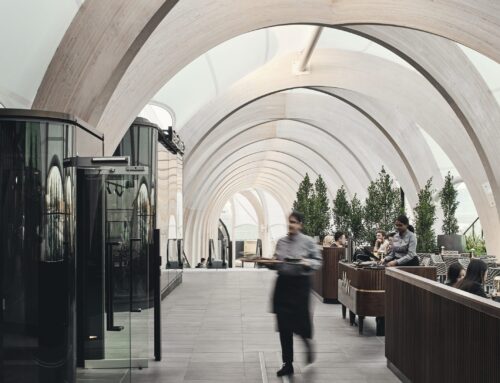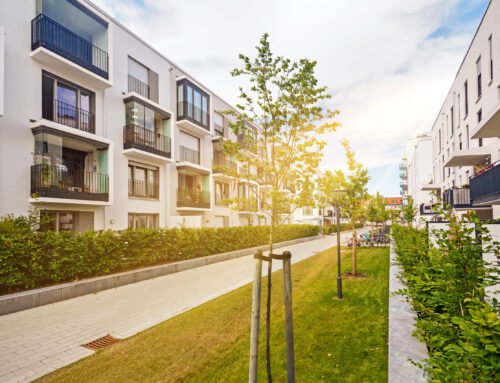Lockdown has allowed space for introspection and reflection for many of us. During Melbourne’s recent lockdowns Tim Bush of NDY Melbourne’s Sustainability team took some time to reflect on some of the sustainability blind spots he sees in his role on building projects across not just Melbourne, but around the Asia Pacific. Tim will be sharing his thoughts on these blinds spots over the coming days on LinkedIn, so head across to his profile to join the conversation.
I’m not sure what it is about the last 12 months – something to do with our personal and professional lives being upended by the pandemic – but it’s been a period in which I’ve increasingly been thinking about our sustainability-related blind spots as an industry. Challenges that we just aren’t discussing – or only very few people are. Where no one seems to be trying to solve the problem – or where the effort being committed seems disproportionately low.
In this series of posts I’m aiming to shine a light on some of the issues that I’ve been reflecting on. I’m sure there are more. And I’m probably wrong about some of them, there might be good work being done that I’m just not aware of. I’d love these posts to become a conversation – and to trigger a series of other conversations that might start to scratch the surface of how we could solve these problems.
Blind Spot #1: Slow Progress on Low Carbon Cements
Concrete use worldwide represents some 8% of global greenhouse gas emissions. It’s rightly been identified as a priority area for construction industry decarbonisation. Beyond Zero Emissions (BZE) released a really good report on the subject in 2017 – Rethinking Cement – Beyond Zero Emissions (bze.org.au).
Based on NDY’s window into the world, it seems like as an industry we can pretty reliably hit the first point under Green Star for Portland cement reduction – and every-so-often a project achieves the second point too. Which might seem like an achievement – but hitting that first point actually only results in an embodied carbon reduction of circa 15 – 20%. And even when the second point is achieved, this only improves to a circa 25 – 30% (Holcim-EPD-ViroDecs_v1.1.pdf (epd-australasia.com). What’s more worrying to me is that this doesn’t seem to have changed much in the last 10 years.
Mass timber construction is no doubt part of the answer – but it’s important not to overstate it’s role. In addition to the cost, fire engineering, and structural dimensions, the land-use implications also need to be considered. Nowhere worldwide are there native forests or plantations that we can squeeze for significant extra production without causing unacceptable ecological impacts – and to that end BZE’s report envisages only about 15% of concrete being displaced by mass timber construction in the long term.
True low carbon concretes – that have say 60%, 70%, 80% less embodied carbon – just don’t seem to be getting the attention they deserve. We haven’t been demanding them from suppliers, and as a result suppliers haven’t been focused on improving the technology and producing them at scale.
It’s understandable why this is the case. For projects pursuing Green Star or Infrastructure Sustainability ratings, the lifecycle carbon emissions linked points can just be made up elsewhere. And the specific concrete-focused point under Green Star (which has been removed from the latest version, but won’t disappear from industry for years to come) perhaps signalled to market, unintentionally, that 15 – 30% reduction was good enough. Combine that with only a tiny fraction of clients specifically briefing that low carbon concretes should be used – and no emissions trading scheme or the like to send a price signal. For most projects there’s just no driver at all.
So what do we do about it? I’m really interested to hear what others think. But here are some thoughts:
- I’m not sure enough structural and civil engineers properly understand the leading-edge of low-carbon concrete mix development
- We probably need to accept it’s going to take time for mixes to be developed that suit all applications. That might mean specifying low carbon mixes in minor applications initially – and thus we probably need to get comfortable with the idea of having two different concrete suppliers on one project
- We really need suppliers to have data available on the embodied carbon of their mixes
- One project doesn’t seem to provide enough lead time for suppliers to change the mixes available at their batch plants and precasting yards – so perhaps it would help to have developers and government agencies making firm commitments about future projects.
Blind Spot #2: Refrigerant Emissions from Small Air Conditioners
Over the past 24 months, the refrigerated air conditioning systems at both my in-laws’ and my own home have lost their entire refrigerant charge to atmosphere. Twice.
In my in-laws’ case, their outside condenser unit failed and had to be replaced. In our case, our new home had a leak in the pipework. In both cases, the repair technician came out, assessed the problem, and recharged the system with new refrigerant as a temporary fix while they arranged parts and personnel to provide a permanent fix. But of course by the time they came back to do the permanent fix, the full charge of refrigerant had been lost to atmosphere again! Maybe it’s a coincidence – but I suspect it’s symptomatic of a wider problem that we’re not discussing.
And it’s probably not just homes – there’s plenty of DX cooling systems installed in apartments and other building types too.
The chillers used in many larger buildings of course have much larger refrigerant charges than small DX systems. But there’s also more incentive to prevent refrigerant leaks: there’s Green Star and Climate Active certifications, and of course a replacement charge of refrigerant just costs a lot more. Couple that with regular maintenance regimes – and based on NDY’s window into the industry, I also suspect that the components, workmanship and pre-commissioning make them less susceptible to leaks.
There’s a nice piece of work I’ve come across from back in 2010, commissioned by DEWHA. It looked exclusively at refrigeration systems – but a lot of the findings feel equally valid for air conditioning systems.
So what do we do about it? I don’t know, that’s a genuine question! But here are my initial thoughts:
- We need to somehow get an understanding of how big an issue this is – so we can gauge how much effort is warranted
- I’m sure better policy, procedures and training for install and service technicians is part of the equation
- I wonder how difficult it would be to adopt regulations that forbid the manufacture and import of certain components that are particularly prone to leaks
- Getting 4th generation refrigerant systems to market seems like it would circumvent a lot of complexity.
Blind Spot #3: Why Isn’t Recycling Easier?
Personally, I get a kick out of minimising what our household sends to landfill. But despite the (unusual) effort I put into researching different materials, I often find myself confused or disappointed. If we’re serious about circular economics, we need the whole community to be great at recycling. Business models that avoid waste e.g. ZeroCo, The Source and KeepCup are important, but we’re never going to totally eliminate packaging and single-use products – and that’s what I really want to focus on in this post.
There’s been some great work done over the past few years to try and make recycling easier – Planet Ark’s Recycling Near You website and the Australasian Recycling Label deserve calling out in particular. But from where I’m standing there still seems a huge number of gaps in the system. I’m sure there’s better ways to categorise the issues, but they include:
- The inconvenience of recycling some materials e.g. expanded polystyrene (only via a small number of tips)
- The very specific rules associated with certain materials e.g. aluminium foil (needs making into a fist-sized ball); paper shopping bags (need any plastic or cloth handles removed)
- The continuing use of materials that can’t be recycled or composted e.g. foil-lined carboard cans; tissue paper; medicine blister packs; most toothpaste tubes
- A complete absence of information about some materials e.g. expanded polyethylene foam; flocked plastic (both used on one product I purchased recently!)
- Misleading symbols on some materials e.g. the ‘Green Dot’; the ‘Tidy Man’ symbol; resin code numbers within a triangle of arrows.
And then we’ve got different councils and various commercial waste contractors that all have slightly different rules e.g. long-life liquid cartons; plastic biscuit trays; leaving glass jar lids on; rinsing or scraping out remnant food. People don’t only exist in one place (2020’s lock-downs aside!), they go to friends’ and family’s houses, work, school, shopping centres. Recycling properly is already complex enough, these differences just add to the confusion.
Manufacturers just need to stop using some materials. Labelling needs improved on all packaging and single-use products, this isn’t just about what’s sold at supermarkets. Education campaigns could be run via social media, internet and TV advertising, rather than hard-copy letterbox-drops. Councils and commercial recycling contractors could all agree upon a common set of recycling rules – in fact maybe government funding should be committed to getting all recycling facilities able to accept the same types of materials.
The property and construction industry can’t tackle the whole problem, but I do think we’ve got a blind-spot – buildings and spaces that make good recycling and composting as easy as possible. I’m really interested to hear what others think we should be doing. But here are my initial thoughts:
- When we built our home recently we put two bin drawers in the kitchen with two bins each – waste, co-mingled recycling, soft plastics and compost. Our builder thought we were a bit mad – but should this not be standard practice? At least for apartments and workplaces?
- At home we also collect minor streams like bottle caps, coffee pods, and aluminium foil – should workplace designers be considering how these could be neatly accommodated in kitchens and start initiating conversations with clients?
- Is it getting any easier to arrange commercial waste collection services for soft plastics? And have we really bottomed-out the best way to compact and store them in a loading dock?
- Who should be taking responsibility for creating effective and attractive educational signage for workplace kitchens, apartment waste chutes and the like?
- NABERS team, I know you’re covering a lot of ground already – but is NABERS Waste for Apartments and Shopping Centres in the works?
Blind Spot #4: Lease Definitions of Thermal Comfort
Many new premium and A-grade office developments, at least through the window NDY has into the world, have started hitting the ceiling of what’s feasible for on-site energy efficiency. Some initiatives that could take them further are very expensive e.g. mixed-mode ventilation, active facades. Others require undesirable compromise on lettable area and tenant amenity e.g. smaller windows, floor-by-floor plant. But there’s one significant opportunity that doesn’t seem to be getting enough attention: relaxing heating and cooling setpoints.
Anecdotally everyone seems to recognise that the 21°-24°C almost universally provided in Australian offices is too cold for a lot of people. That’s supported by mathematical models of thermal comfort like ASHRAE Standard 55 – typical office attire today just isn’t as insulating as it was 40 years ago. There’s probably other considerations too – radiant temperatures might be lower now that most of us are working on laptops with LED-LCD displays. And then the greater diversity in clothing, gender, physiques, commuting method, is no doubt an aggravating factor.
These twin challenges have a few potential solutions that tend to get most of the attention:
- Running buildings a degree or so warmer – say 22°-25°C – but people may feel too warm when they first enter the office (their metabolic rates still elevated from walking)
- Widening the temperature band by a degree or two – say 20.5°-25.0°C – which improves energy efficiency, but doesn’t do anything to improve thermal comfort. CitySwitch’s ‘Expand the Band’ campaign is worth a look
- Providing different temperatures in different parts of the floor – with people free to choose where they’re most comfortable, or with people given the ability to adjust the setpoints in their local zone (per WELL v2). This is the most technically difficult of the three, and is detrimental to energy efficiency.
The solution I do see a lot of promise in though is a pseudo adaptive thermal comfort approach, where the building’s internal temperature setpoints change based on external weather. True adaptive thermal comfort as a model is based on people having the ability to open and close windows. But one part of that model – the reasoning that on a cold day people are happy to dress more warmly, and vice versa – has relevance to the majority of Australian buildings. It means you can have lower heating setpoints on cold days, and higher cooling setpoints on hot days – and because the difference between indoor and outdoor temperature isn’t as large, you save energy. The technology to do this exists now. Each morning, the building’s management system can go online to check the weather forecast (in the same way you or I would when choosing clothes for the day ), and then choose a band 3°C wide that will be used for the day. On a very cold winter’s day that might be 19.5°-22.5°C; on a very hot summer’s day that might be 23°- 26°C. The precise mapping of forecast temperatures to internal temperature setpoints would need to be tuned in operation – but that’s pretty straightforward. So why aren’t we seeing more of it?
There’s probably a number of reasons. The one that sticks out to me is how thermal comfort is defined in commercial leases. The majority of leases that I’ve seen over the years obligate the landlord to maintain 22.5°C ± 1.5°C (i.e. 21°-24°C) – and entitle the tenant to a rent abatement (i.e. a discount) if conditions are outside this range. That’d have to change, we’d need to introduce more sophisticated definitions of thermal comfort to leases – or perhaps there’s some other way to do it.
Is there other things holding buildings back from adopting weather-forecast based temperature setpoints? As before, I’m keen to hear other’s thoughts!










